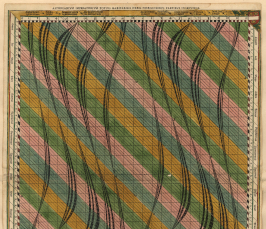Conference: Diagrams in Science, Science in Diagrams
- Online event via Zoom
- Beginn: 14.06.2021
- Ende: 18.06.2021
- Vortragende(r): Conference
- Kontakt: boehm@biblhertz.it

As natural and familiar as these abstract forms of representing information are to us, they are products of many historical developments. Their historical roots may go back to prehistoric epochs. However, the historical integration of diagrams in scientific contexts is relatively recent. Even if these developments with regard to Western cultures have their origin in antiquity and were significantly developed further in the sciences of the Middle Ages, the early modern period can be considered the first flourishing phase of the diagram in practically all areas of the sciences of that time.
This event proposes to trace this historical development in the early modern period. It takes a truly interdisciplinary approach when talking about a timespan of roughly 500 years (1300-1800) across all early modern sciences, from Architecture to Zodiac men in medicine. The talks bring together research on the culture of the diagram in various sciences of the epoch to form a large overall picture.
This event aims at tracing the emergences and the disruptions of traditions of diagrams in all fields of scientific theory and practice, e.g. (but not restricted to) geometry, astronomy, medicine, philosophy, alchemy, law, theology, and music.
It will address, among others, questions such as the following:
1. Do the diagrams under investigation come
from a precise tradition or do they form the foundation of such a tradition?
2. What is the scientific/disciplinary context of the diagrams under investigation and how do they relate to it?
3. What is the aim of the diagrams under investigation (illustration, explanation, demonstration, etc.)?
4. How does the medium carrying diagrams under investigation impact their form and role (print, manuscript)?
5. What are the most intriguing visual/graphical features to be found in the diagrams under investigation?
6. How do the diagrams under investigation interact with the text and which vocabulary is used to refer to the diagrams?
7. What justifies the diagrams under investigation to be labelled as ‘diagrams’ (and not ‘tables’, ‘maps’, etc.) and what is a reasonable demarcation line here?
8. How do the diagrams under investigation relate to scientific practices (experiments, taking measures, etc.)?
Please note, this event consists of a closed workshop (14 – 18 June 2021)
and public key-note lectures.
The key-note lectures
are open to the public and will take place entirely online.
Registration link: https://bit.ly/3soQOam
Program key-note lectures
Monday, 14.06.2021 18:00- 19:00 (CET)
How Early Modern Readers Used Geometrical Diagrams
Speaker: Benjamin Wardhaugh (University
of Oxford)
Chair: Katherine Reinhart
(Bibliotheca Hertziana - Max Planck Institute for Art History)
Tuesday, 15.06.2021 18:00- 19:00 (CET)
Sound Colour Space – A Guided Tour Through a Museum of Diagrams
Speaker: Daniel Muzzulini (Zurich
University of the Arts)
Chair: Oscar Seip (Bibliotheca
Hertziana - Max Planck Institute for Art History)
Wednesday, 16.06.2021 18:00- 19:00 (CET)
The Introduction of the Timeline
Speaker: Christoph Lüthy (Radboud
University Nijmegen)
Chair: Christoph Sander (Bibliotheca Hertziana
- Max Planck Institute for Art History)
Thursday, 17.06.2021 18:00- 19:00 (CET)
"Her Hair Was Beautifully Groomed, but Her Feet Were Covered with Dust":
Geometrical Diagrams in Sacrobosco’s Sphere
Speaker: Kathleen Crowther
(University of Oklahoma)
Chair: Mattia Mantovani (KU Leuven)
Workshop participants:
Solène Baron (Université Paris-Diderot)
Patricia Pia Bornus (Universität
zu Köln)
Tamara Caulkins (Central Washington University)
Michela Cigola (Università di Cassino e del Lazio
meridionale)
Michael Friedman
(Humboldt-Universität zu Berlin)
Arturo Gallozzi (Università di Cassino e del Lazio
meridionale)
Sarah Griffin (Winchester
College)
Eunsoo Lee (Stanford
University)
Jens Lemanski (FernUniversität
in Hagen)
David J. LePoire (Argonne
National Laboratory)
Iulia Mihai (Ghent University)
Ion Mihailescu (Laboratory for the History of Science
and Technology, Lausanne)
Amirouche Moktefi (Tallinn University of Technology)
Daniel Muzzulini (Zurich University of the Arts)
Yelda Nasifoglu (University of Oxford)
Sara Öberg Stradål (The Fitzwilliam Museum, Cambridge)
Sergio H. Orozco-Echeverri (The University of
Edinburgh)
Margaret Schotte (York University, Toronto)
Elaine Condouris Stroud (Independent Scholar, Madison,
Wisconsin)
Aníbal Szapiro (Universidad de Buenos Aires)
Naïs Virenque (Université Catholique de Louvain)
Susan Forscher Weiss (The Johns Hopkins University)
Scientific Organization: Sietske Fransen, Katherine Reinhart and Christoph Sander